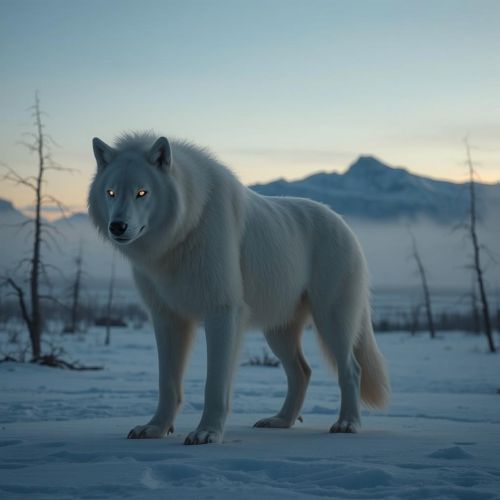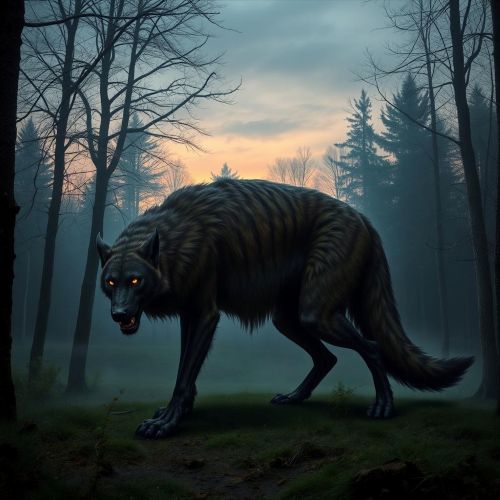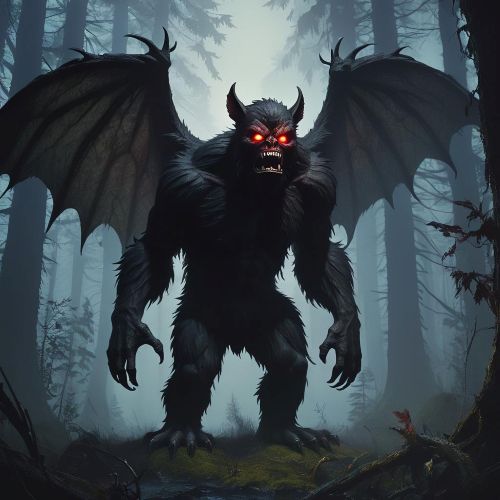
Waheela : The Giant Wolf
| Description | |
|---|---|
| Origin | Canada |
| Classification | Cryptid |
| Demeanour | Predatory |
| Habitat | Forests |
| Status | Not Proved |

Introduction
The Waheela is a mysterious cryptid said to prowl the remote northern landscapes of North America. Often described as a wolf-like beast of immense size, it occupies a dark space between folklore, cryptozoology, and indigenous legend. Unlike more popular creatures such as Bigfoot, the Waheela remains an obscure yet chilling figure, tied closely to stories of unexplained deaths and supernatural warnings. Sightings and reports center on Alaska, the Canadian Northwest Territories, and parts of northern Michigan, where tales of a monstrous white wolf continue to circulate.
Physical Attributes
Descriptions of the Waheela suggest a creature much larger and more robust than ordinary wolves. Standing around three and a half to four feet at the shoulder, it dwarfs even the Mackenzie Valley wolf, one of the largest known subspecies. Its broad face resembles a mix between a bear and a wolf, with an unusually wide skull and a powerful jawline. Accounts frequently note its long, shaggy white fur that blends seamlessly into snowy terrain, giving it a ghost-like quality.
One of its most unusual traits is its massive feet, with toes spaced more widely than those of modern wolves, allowing it to move easily over snow and rough landscapes. Some legends claim its hind legs are shorter than its forelegs, giving the Waheela a sloping posture and a lumbering gait. With a dense tail and small, rounded ears almost hidden by its fur, the animal has a prehistoric look that fuels speculation about its origins. For many eyewitnesses, its sheer build and presence leave an impression of raw, otherworldly power.
First Sighting/Reporting
The earliest mentions of the Waheela come from Native American traditions, especially among the Dene people of Canada. In these stories, the Waheela is no ordinary animal but a spirit predator with supernatural abilities. It is said to wander remote valleys, killing intruders and sometimes leaving their bodies headless, a chilling connection to the Nahanni Valley’s infamous nickname—the “Valley of the Headless Men.”
In the 20th century, cryptozoologists began to pay closer attention to these stories. Ivan T. Sanderson, a well-known researcher, suggested that the Waheela could be a relic of prehistoric carnivores that survived extinction. He documented reports of hunters encountering a massive white wolf in the Nahanni Valley and even stories of bullets bouncing harmlessly off its thick coat. Later accounts, like those recorded by Loren Coleman, connected the legend to early colonial trappers in Michigan who spoke of giant phantom wolves.
One of the more famous modern sightings came from Frank Graves, an American mechanic, who described the Waheela as a “wolf on steroids.” However, he later admitted in a 2018 documentary that the creature he saw was most likely a Mackenzie timber wolf. Still, the earlier connection of his sighting to the Waheela legend ensured that its presence would remain in cryptozoological lore.
Other Names
Over the years, the Waheela has been known by different names across cultures and regions. Some cryptid enthusiasts call it the “Saberwolf,” emphasizing its strength and ferocity. Indigenous groups such as the Ioway referred to a similar beast as the Shunka Warak-in, meaning “carrying-off-dogs,” linking it to tales of animals disappearing mysteriously. Comparisons are often drawn between the Waheela and other legendary wolves, such as the Inuit Amarok, a solitary white wolf said to devour hunters, or even Fenrir from Norse mythology, a monstrous wolf tied to apocalyptic myths.
Some theories go further, suggesting that the Waheela might be a surviving descendant of prehistoric beasts like the dire wolf, which roamed North America during the Ice Age, or the Amphicyonid, commonly called the bear-dog. These ancient carnivores combined features of wolves and bears, much like the descriptions of the Waheela today. While no scientific evidence supports these claims, the comparisons highlight how this legend often blends folklore with paleontology.
Modus Operandi
Legends portray the Waheela as a solitary hunter, unlike wolves that move in packs. It stalks isolated regions, appearing without warning and attacking those who trespass into its territory. One of its most terrifying trademarks is the alleged decapitation of its victims, which is why the Nahanni Valley stories persist so strongly. The belief that it can remove a human head with one swift bite reinforces its reputation as more than just a flesh-and-blood predator.
The Waheela is also said to possess supernatural qualities. Some accounts suggest it can appear and disappear at will, leaving no tracks behind. Others describe it as a spirit guardian that punishes disrespect toward sacred or forbidden lands. Whether viewed as a physical beast or a spiritual enforcer, the Waheela occupies a liminal space between predator and phantom, keeping its reputation alive through fear and fascination.
Pop Culture References
Although the Waheela is less famous than creatures like the Chupacabra or Bigfoot, it has still found a place in popular culture. The animated series The Secret Saturdays features the Waheela, and it also appears in the related video game Beast of the Fifth Sun. In reality television, it was the subject of an episode of Alaska Monsters, where a team of hunters attempted to track it in the wild.
In literature, the Waheela appears in the InCryptid novel series, where one character named Istas is depicted as a Waheela who can shift between human and beast form. This modern interpretation reimagines the creature as a therianthrope, bridging folklore with fantasy storytelling. Its presence in role-playing games, cryptid-themed podcasts, and YouTube documentaries continues to introduce the Waheela to new audiences, ensuring its legend survives in contemporary imagination.
Current Status
Today, the Waheela remains one of North America’s enduring cryptid mysteries. Despite the numerous sightings and stories, no physical evidence has ever been found to confirm its existence. Skeptics argue that most encounters are misidentifications of large wolves, bears, or hybrids, while believers maintain that the Waheela is a survivor from prehistoric times.
In regions like Michigan and the Canadian Northwest Territories, the Waheela’s legend continues to overlap with other local myths, such as the Dogman, reinforcing its place in regional folklore. For many, the Waheela is less about scientific proof and more about symbolic meaning—an embodiment of the dangers and mysteries of the wilderness. In vast, untouched landscapes where humans are vulnerable, stories like that of the Waheela serve as reminders of nature’s unpredictability and the lingering possibility that some ancient beasts may still walk among us.
Source
Steemit. (n.d.). Waheela: North American Folklore. Retrieved from https://steemit.com/folklore/@pinkspectre/waheela-north-american-folklore
MysteriesOfCanada. (2018, May 25). Waheela- the Great White Wolf of Northern Canada. Retrieved from https://mysteriesofcanada.com/nwt/waheela-the-great-white-wolf-of-northern-canada/
Fandom. (n.d.). Waheela – Cryptid Wiki. Retrieved from https://cryptidz.fandom.com/wiki/Waheela
Pucaprinthouse. (2023, October 25). Mythical beasts of canada. Retrieved from https://www.pucaprinthouse.com/post/mythical-beasts-of-canada
BeastPedia. (2009, August 24). Waheela. Retrieved from http://beastpedia.blogspot.com/2009/08/waheela.html
Karl Shuker. (2011, February 16). WITCHIE WOLVES, MEDICINE WOLVES, AND THE WAHEELA. Retrieved from https://karlshuker.blogspot.com/2011/02/witchie-wolves-medicine-wolves-and.html
Cryptidophilia. (n.d.). Waheela – Canada’s Elusive Wolf-Like Cryptid. Retrieved from https://www.cryptidophilia.com/waheela/
Wikipedia. (2013, November 25). Waheela, la enciclopedia libre. Retrieved from https://es.wikipedia.org/wiki/Waheela









